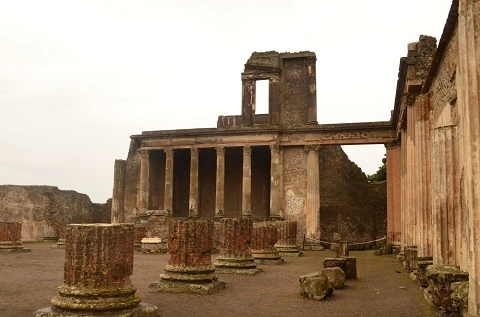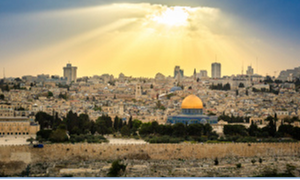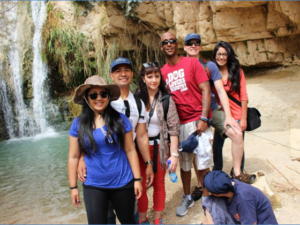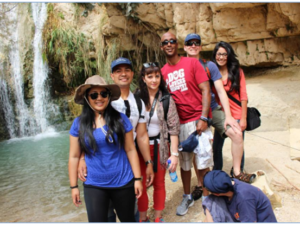
Must-Visit Historical Attractions in Israel
A nation enriched by its complex religious, cultural, and political tapestry, Israel boasts numerous monumental sites essential for anyone yearning to delve into its profound history. Dive into our selection of the top destinations you cannot overlook.
The territory recognized today as Israel has been a crossroads for religions, dynasties, and civilizations from ancient times. Its historical wealth is truly unparalleled.
From the time-honored city of Jerusalem to the ancient ports complemented by the country’s top-notch contemporary museums, the dilemma for a traveler often becomes where to begin.
For those needing a nudge, here’s our compilation of Israel’s most iconic sites, including hidden gems waiting to be discovered.
Israel’s Premier Historical Landmarks:
Church of the Holy Sepulcher:
Held in the highest regard by Christians, this Jerusalem church covers the final stations of Christ’s journey, and houses what many believe is Jesus’ tomb, giving the church its name.
Now safeguarded by six Christian denominations, it has been a UNESCO World Heritage site since 1981, nested within the ancient walls of Jerusalem.
Constructed in 325/6 AD under the patronage of Roman Emperor Constantine I, who was notably the first of his title to embrace Christianity, the Church of the Holy Sepulcher stands on what is believed by many Christians to be Golgotha or The Hill of Calvary.
This is where it’s believed Jesus was crucified and subsequently resurrected. The church’s name, “Sepulcher,” which translates to the tomb, stems from the conviction that it envelops the burial place of Jesus.
Helena, Constantine’s mother, pinpointed this sacred site in Jerusalem. Interestingly, before the church’s establishment, this location was home to a temple dedicated to the goddess Aphrodite, constructed under Emperor Hadrian’s reign.
At the heart of the church lies the Sepulcher, deemed the burial spot of Jesus, while nearby within The Hill of Calvary resides the remaining four stations, lavishly decorated and believed to mark Jesus’ crucifixion spot.
Over the ages, the Church of the Holy Sepulcher has witnessed its fair share of destruction and reconstruction. Its structure predominantly hails from the twelfth century, post the First Crusade.
The site’s management is a collaboration between six Christian denominations, a division which originated in the 11th century and was finalized by the Ottomans in 1767.
While this arrangement is well-intentioned, it often complicates decision-making processes, leading to prolonged restoration efforts.
Recognizing its immense significance, UNESCO inscribed the Church of the Holy Sepulcher as a World Heritage site in 1981, positioning it within the Old City of Jerusalem and its Walls.
The Sea of Galilee
Also known as Lake Tiberias or Kinneret, the Sea of Galilee is where Jesus performed many miracles, including walking on water and calming the storm.
The area around the sea boasts numerous Christian sites such as the Mount of Beatitudes, where Jesus delivered the Sermon on the Mount; Tabgha, the location of the miracle of the multiplication of the loaves and fishes; and Capernaum, where Jesus taught and healed.
Historical and Religious Significance
- Christianity: The Sea of Galilee holds a special place in Christian theology. According to the New Testament:
- Jesus performed several miracles here, including walking on its waters and calming a storm.
- The region around the lake had several towns, like Capernaum, where Jesus conducted many teachings and healings.
- Jesus recruited several of his disciples, who were fishermen, from the shores of this lake.
- Archaeological Findings: Recent archaeological expeditions around the Sea of Galilee have unearthed ancient boats, settlements, and synagogues, providing a glimpse into life during the times of Jesus.
In summary, the Sea of Galilee is not just a geographical landmark; it’s a place where history, religion, and modern-day life intersect. Its significance spans millennia and remains a focal point for faith, history, and ecology.
Via Dolorsa, Jerusalem
Via Dolorosa, meaning “Way of Sorrow,” is the path Jesus is believed to have taken on His way to crucifixion. Christians worldwide walk this path, reflecting on the 14 Stations of the Cross that mark significant events from Jesus’s condemnation to His burial.
Historical and Religious Background
- The Stations: The Via Dolorosa is traditionally segmented into 14 stations, representing specific events as Jesus made His way to Golgotha (Calvary). Nine stations are located along the route, and the remaining five are inside the Church of the Holy Sepulcher.
- 1st to 3rd Stations: Jesus is condemned to death, takes up His cross, and falls for the first time.
- 4th to 6th Stations: Jesus meets His mother, Mary; Simon of Cyrene helps Jesus carry the cross.
- 7th to 9th Stations: Jesus falls for the second time, meets the women of Jerusalem, and falls for the third time.
- 10th to 14th Stations (inside the Church of the Holy Sepulcher): Jesus is stripped of His clothes, nailed to the cross, and dies on the cross; His body is taken down, and He is laid in the tomb.
- Origins: The tradition of retracing Jesus’ final steps began with early Christian pilgrims in Jerusalem. However, the route has changed multiple times over the centuries for various reasons, including religious, historical, and geographical factors.
- The Name: “Via Dolorosa” was first used in the 16th century to describe this route.
Modern-Day Significance
- Pilgrimage: Every year, thousands of Christian pilgrims around the globe visit Jerusalem specifically to walk the Via Dolorosa, especially during the Lenten season leading up to Easter. The most notable event is the Friday procession, led by the Franciscan monks, which has been a tradition for several centuries.
- Surrounding Features: The path winds through a bustling part of the Old City, with markets, shops, and historic buildings lining the way. This juxtaposition of the sacred and the every day brings a unique ambiance to the experience.
The Via Dolorosa isn’t just a historical path; it’s a journey through the heart of Christian faith and spirituality. For many, walking this route is a profound act of devotion and reflection, tracing the final steps of Jesus’ earthly life.
Bethlehem
Just south of Jerusalem, Bethlehem is the birthplace of Jesus. The Church of the Nativity is a testament to this pivotal moment in Christian history. The church is built over the grotto where Mary gave birth to Jesus.
Historical and Religious Significance
- Birthplace of Jesus: The most defining feature of Bethlehem for many is the belief that it’s the birthplace of Jesus Christ. The Gospels of Matthew and Luke in the New Testament describe Bethlehem as the birthplace, marking it as a holy site in Christianity.
- Rachel’s Tomb: Located at the entrance of Bethlehem, this is believed to be the burial place of the biblical matriarch Rachel.
Key Sites
- Church of the Nativity: One of the oldest continuously operating churches in the world, this basilica was commissioned by Emperor Constantine in the 4th century over the site believed to be the birthplace of Jesus. The exact spot is marked by a star in a grotto beneath the church. The Church of the Nativity is a UNESCO World Heritage site.
- Shepherd’s Field: According to the New Testament, shepherds in this field were the first to hear the news of Jesus’ birth. Today, there are several chapels in the area commemorating this event.
With its intricate tapestry of history, faith, and culture, Bethlehem remains a beacon for those seeking a deeper understanding of Christian origins. Despite modern challenges, its enduring significance and the warmth of its inhabitants make it a must-visit for those interested in the rich tapestry of the Holy Land’s history.
The Israel Museum, Jerusalem
While it covers the broader spectrum of Israel’s history and culture, the Israel Museum houses the Shrine of the Book, which displays the Dead Sea Scrolls, the oldest biblical manuscripts.
Major Exhibits and Sections
- The Shrine of the Book: This iconic wing houses the Dead Sea Scrolls, the oldest biblical manuscripts found at Qumran in the 1940s and 1950s. The shrine’s architecture, with its contrasting white dome and black wall, symbolizes the spiritual themes of light and darkness, good and evil.
- The Billy Rose Art Garden: Designed by Japanese-American sculptor Isamu Noguchi, this outdoor sculpture garden showcases works from the 19th and 20th centuries by renowned artists such as Pablo Picasso, Henry Moore, and Auguste Rodin.
- The Archaeology Wing: This section offers a chronological journey through the history of the Land of Israel, from prehistoric times to the Ottoman period, showcasing artifacts from various civilizations that lived in the region.
- Fine Arts Wing: Here, visitors can enjoy a vast collection of artworks from across the world, spanning various periods and styles, including pieces by renowned artists like Vincent van Gogh, Rembrandt, and many others.
- Judaica and Jewish Ethnography Wing: This section delves deep into Jewish religious practices, traditions, and diverse communities worldwide, offering insights into Jewish life over the centuries.
- Youth Wing: This section is dedicated to young visitors and focuses on art education, offering workshops, classes, and exhibitions tailored for children.
Special Features
- Model of Jerusalem: A detailed model of Jerusalem during the Second Temple period, giving visitors a tangible sense of the city’s layout and architecture during a pivotal era of its history.
- Temporary Exhibitions: The museum frequently hosts temporary exhibitions, showcasing pieces from its vast storage or loans from other global institutions.
Modern Significance
The Israel Museum serves as a cultural hub for Israel and the broader Middle East. It plays a vital role in preserving the region’s rich heritage while promoting contemporary art and creativity.
The Israel Museum is a testament to the rich tapestry of histories, cultures, and traditions that have shaped Israel and the broader region. It offers an unparalleled journey through time, making it a must-visit for anyone travelling to Jerusalem.
The Museum of the Good Samaritan
Location: Situated on the road from Jerusalem to Jericho, the museum is approximately 12 kilometers from Jerusalem, near the Ma’ale Adumim settlement.
Historical Context:
The museum is located near the traditional site where the biblical parable of the Good Samaritan took place. The parable in the Gospel of Luke (10:25–37) tells of a Samaritan who helps a traveller who has been beaten, robbed, and left for dead, demonstrating the virtues of compassion and love.
Museum Highlights:
Mosaic Collection: The museum is renowned for its vast collection of mosaics. These mosaics originate from Christian sites throughout the Judea, Samaria, and Gaza regions. Their intricate designs and motifs provide insights into the region’s ancient cultures and religious practices.
Ancient Ruins: The museum’s site was originally a Byzantine-era inn and adjacent church. Excavations have revealed the foundations of these structures, which are thought to have served travellers and pilgrims journeying between Jerusalem and Jericho.
Chapel: The modern chapel adjacent to the museum is not just a place of reflection. It houses replicas of some of the mosaics found in the main museum, allowing visitors to see them in a more spiritual or contemplative setting.
Outdoor Exhibits: The museum’s grounds contain ruins and reconstructions of various periods, from the Second Temple era to the Ottoman period. This includes ritual baths, cisterns, and other ancient structures.
Interfaith Significance:
One of the unique aspects of the Museum of the Good Samaritan is its focus on the interplay and coexistence of various religious traditions in the region. By showcasing artifacts and relics from a Christian context, the museum emphasizes these communities’ shared historical and spiritual legacy.
The Museum of the Good Samaritan offers a blend of archaeological, historical, and spiritual experiences. For those interested in the rich tapestry of the Holy Land’s history and the shared legacies of its diverse inhabitants, this museum is a must-visit.
Ready for more?
Embarking on a journey through these historical wonders in Israel, one is bound to experience a mosaic of cultures, tales, and epochs, offering insights into the nation’s layered past.
Coral Tours stands out as a beacon for those eager to tread the sacred pathways of the Holy Land. Specializing in Israel Christian tours, this esteemed agency offers a profound journey explicitly tailored for the faithful.
Whether you’re considering trips to Israel for Christians or seeking the best Christian tours of Israel, Coral Tours has the expertise and dedication to make your spiritual journey a transformative experience. So, for those looking to deepen their connection and embark on memorable Christian trips to Israel, look no further than the trusted guidance of Coral Tours.






